Key Insights
- The partial liquidation of the BSC Token Hub exploiter’s position generated $3.3 million in revenue for VenusDAO and reduced the BNB collateral balance by $66 million.
- Venus Prime is slated to launch in Q4, granting access to enhanced yields via direct revenue share for eligible XVS stakers.
- Protocol interest revenue increased 45% QoQ to $3.3 million.
- Venus’ markets saw an 18% QoQ decline in the total value supplied, primarily due to significant outflows of BTC, USDT, BUSD, and ETH.
- All outstanding BUSD loans will face forced liquidation in October to enable users to redeem their supplied BUSD.
- Venus experienced a notable divergence in user activity characterized by a 117% surge in the number of depositors, which contrasted with a 27% decline in the number of borrowers.
Primer on Venus
Venus is a decentralized finance (DeFi) platform that operates on the BNB Chain, offering a robust money market protocol for the crypto community. At its core, Venus enables users to deposit a variety of cryptoassets, which can then be borrowed by others. Unlike traditional financial systems where interest rates are often set by central entities, Venus employs a unique algorithmic approach. The interest rates for borrowing and lending on Venus are dynamically adjusted based on an interest rate model. This model takes into account the utilization ratio, which is the proportion of deposited assets that have been borrowed.
The utilization ratio is a critical component of the Venus protocol. When there’s a high demand for borrowing a particular asset, the utilization ratio increases, leading to a rise in interest rates. Conversely, when the demand for borrowing is low, the utilization ratio decreases, causing interest rates to drop. This dynamic adjustment ensures that the system remains balanced, incentivizing lenders when demand is high and borrowers when it’s low.
The entire protocol is overseen by the Venus DAO community. This is facilitated through the XVS token, which acts as the governance token for the Venus protocol. Holders of the XVS token can actively participate in the governance process, proposing changes or voting on proposals made by others. Additionally, holders have the option to stake their tokens in a specialized vault that comes with financial incentives. Per the Venus tokenomics model, stakers are entitled to a share of the protocol’s revenue, ensuring that those who actively participate in the platform’s governance are rewarded for their contributions.
Key Metrics
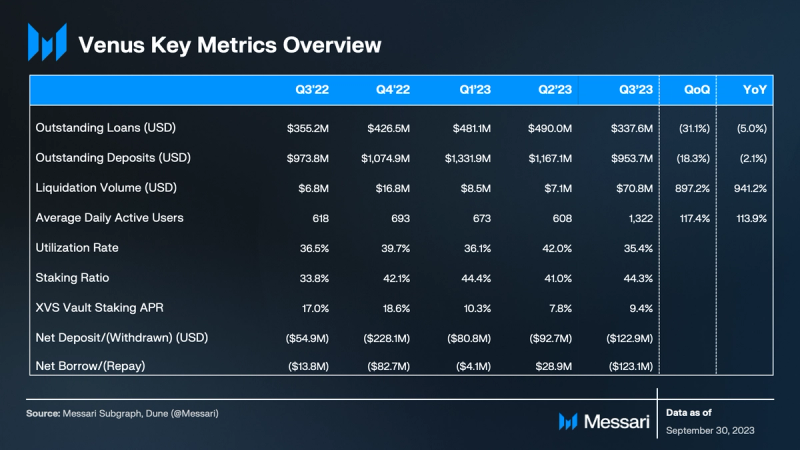
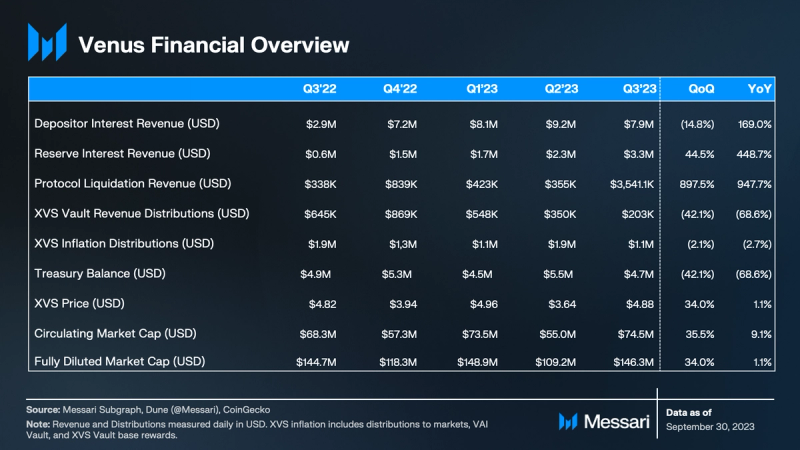
Performance Analysis
Usage
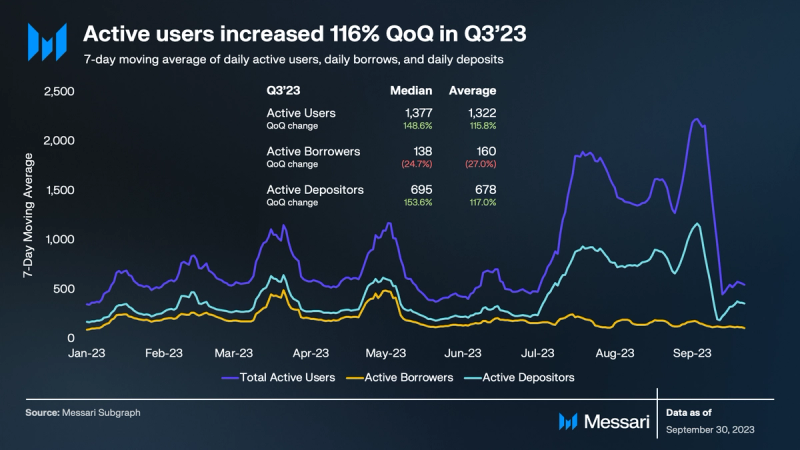
In Q3, the Venus protocol experienced a notable divergence between depositor activity and borrower activity. The number of daily depositors surged 117%, while the number of borrowers declined by 27%. These changes led to an overall increase of 116% in active users and marked a departure from historical patterns where the number of depositors and borrowers typically trended in tandem. This shift is likely due to a substantial portion of the depositor activity being driven by users adding collateral to support existing loans. Furthermore, the decline in borrower activity could indicate a diminished demand for new leverage, possibly reflecting a more cautious approach by users in the current market environment.
Total Value
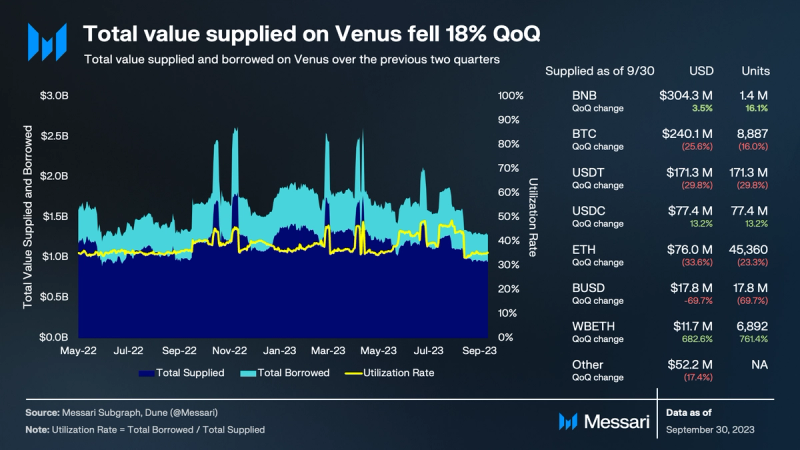
Venus’ markets experienced an aggregate 18% QoQ decline in the total value supplied, a drop more than double that of the global cryptocurrency market cap. This decline was primarily attributed to significant outflows of BTC, USDT, BUSD, and ETH, totaling $183 million, valued at quarter-end prices.
The BUSD withdrawals have been achieving the intended result of Venus Improvement Proposal 161 (VIP-161), which outlined a deprecation plan for BUSD. As BUSD liquidity becomes increasingly scarce due to being sunsetted by its issuer Paxos, loans collateralized by BUSD pose an escalating liquidity risk to the protocol, given that liquidations require sufficient open market liquidity.
Despite this overall decrease, Venus saw notable inflows in BNB, USDC, and WBETH, collectively valued at $61 million, signifying a major shift in collateral preferences within the Venus ecosystem. Previously, BTC, USDT, and ETH constituted the lion’s share of value supplied, excluding the frozen BNB supply from the BSC TokenHub exploiter.
Intra-quarter, the WBETH supply underwent a temporary surge, increasing from 9,500 to over 15,000 units within just 48 hours. It maintained this level between August 22 and September 3. This sudden influx was key in expanding the WBETH supply cap from 800 to 27,000 units. However, the actual number of WBETH supplied sharply declined to 7,400 units within the next 24 hours due to withdrawals. As of quarter-end, the largest WBETH supplier accounted for nearly 50% of the total WBETH supplied on Venus, and the Venus WBETH market had become the fourth-largest holder of WBETH, trailing only behind Binance Exchange wallets. In addition, the largest liquidity pool for WBETH on BNBChain had less than $3 million of liquidity as of quarter-end. While the largest supplier’s position remains healthy, the lack of sufficient liquidity in the open market could pose a risk to the liquidation process.
Interest Revenue
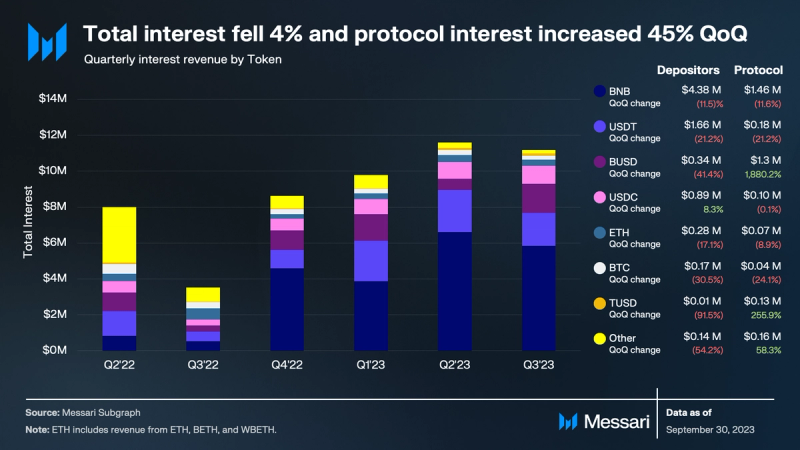
After increasing for three consecutive quarters, the total interest revenues generated from Venus markets dipped by 4% QoQ. The decline can be attributed to a combination of factors, including a decrease in the price of BNB and a diminished demand for BNB sourced from Venus to participate in recent Binance Launchpad events. This drop in demand was evidenced by both the stagnant number of borrowers and the lower utilization of BNB deposits during these events.
While total interest experienced a slight decline, the protocol’s allocation notably increased by 45%. The driver of this growth was the BUSD market, which experienced a surge in protocol interest of more than 1,800% as a result of VIP-161 initializing the BUSD market deprecation plan.
This initiative froze new supply and borrowing, set the reserve factor to 100%, and ultimately led the protocol to generate more than $36,000 per day on average. However, it’s important to note that this specific revenue stream is expected to conclude in October. In late September, introduction of VIP-172 added a “forced liquidation” mechanism to the Core pool, targeting the liquidation of the remaining rate-insensitive accounts with outstanding BUSD loans. This will enable BUSD depositors to withdraw their funds in time to redeem them with Paxos for U.S. dollars. As of now, BUSD is the sole market with the forced liquidation feature activated. Users wishing to verify the functionality for other markets can do so by invoking the function Comptroller.isForcedLiquidationEnabled(address vToken) on the Comptroller contract of the pool.
Revenue vs. XVS Rewards
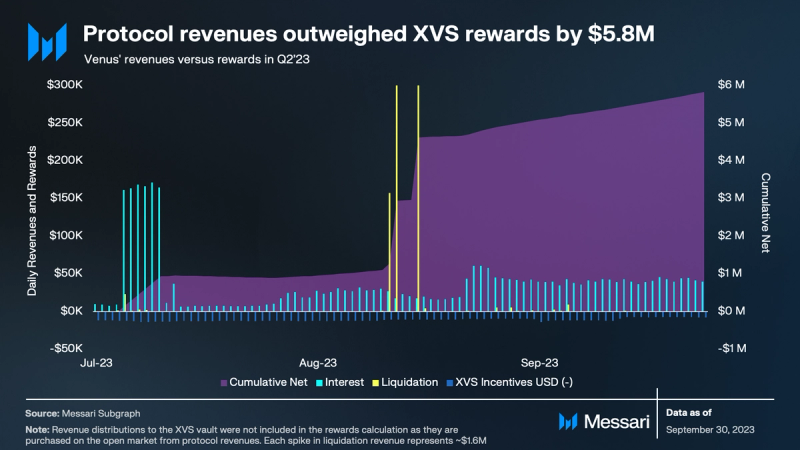
In Q3, the revenues from protocol interest and liquidations outweighed the value of XVS incentives disbursed to users by a margin of $5.8 million. This marked a significant increase from the $800,000 surplus recorded in Q2. This growth was primarily driven by the liquidations, followed by the interest earned from BUSD market. In total, liquidations amounted to $70.8 million and generated $3.5 million in revenue for the VenusDAO. Notably, 93% of the liquidation revenue was generated from the partial liquidation of the BSC Tokenhub exploiter’s position and will be used to cover bad debts. This liquidation was carried out by the BNB Chain’s core team on August 18 and August 21 in four separate transactions.
As of September 30, 2023, the position maintained an outstanding loan balance of just under $95 million and hovered within a 7% price drop from being subject to further liquidation. This balance was comprised of $57.7 million in USDT and $37 million in USDC and was collateralized by 676,000 BNB worth $135 million.
Additionally, the DAO unanimously voted to slash market emissions by 75% in VIP-171. This strategic move not only further enhanced the net earnings but also underscored the DAO’s commitment to cultivating a more organic and sustainable reward system within Venus Prime.
XVS Vault
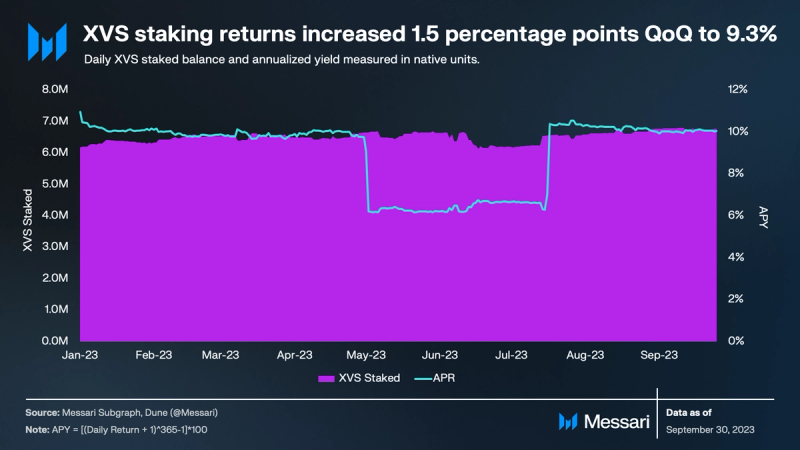
In addition to receiving $481,000 of inflationary XVS rewards (1,100 XVS per day), XVS stakers also received $203,000 in XVS tokens from protocol buybacks. This adjustment elevated the XVS staking yields back to above 9%, aligning with the team’s expectations as outlined in VIP-113. Moving forward, XVS stakers will gain the opportunity to effectively boost staking yields through the Venus Prime incentive Program.
Borrower Perspective
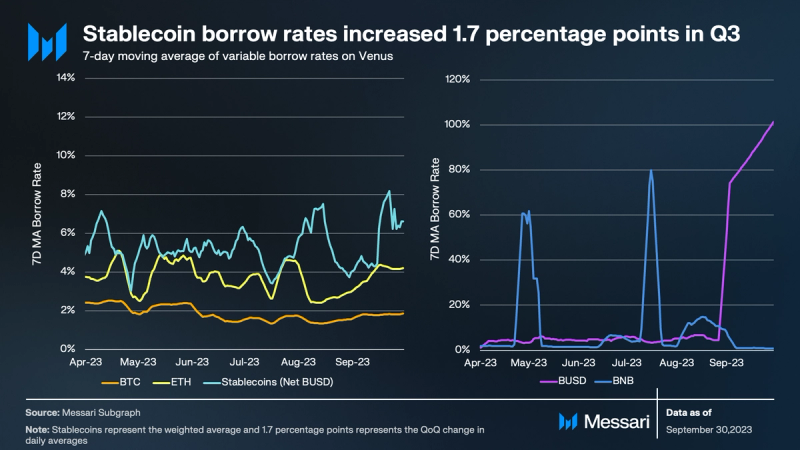
In Q3, the average borrow rate for stablecoins, excluding BUSD, rose by a mere 1.7 percentage points. In contrast, the borrow rate for BUSD skyrocketed to over 100%. This surge was a reaction to VIP-161, as users rapidly withdrew over a third of the BUSD supply overnight, in contrast to the 17% of BUSD loans that were repaid. Consequently, the utilization rate exceeded 100%. By quarter’s end, only about 33% of the initial BUSD supply remained, while 54% of the borrowed amount continued to accrue compounding interest. As highlighted earlier, these outstanding loans are slated for forced liquidation in October, regardless of any overcollateralization.
Qualitative Analysis
Venus V4 Update
In Q2, the Venus team made significant strides by releasing Isolated Pools and Resilient Price Feeds. Following these releases, the team’s efforts were focused on final security checks essential for the full deployment of the Venus V4 upgrade and its most exciting features. This entailed an investment of $300,000 to fund smart contract audits, ensuring the robustness of features like the Venus Prime program, the VAI Peg Stability Module, and the automation of income stream allocations. Five entities, namely OpenZeppelin, Code4rena, PeckShield, Quantstamp, Fairyproof, and CertiK, were commissioned to conduct these audits.

Source: Venus
The anticipated Venus Prime program, first introduced a year prior, is slated for launch in the early days of Q4. This initiative aims to incentivize user engagement and XVS staking, while simultaneously increasing the protocols TVL. It plans to achieve this by awarding soulbound tokens to users who stake at least 1,000 XVS for 90 days in a row, granting them access to enhanced yields via a direct revenue share. The reward system is made possible through the newly introduced Automatic Income Allocation module and various Token Converter contracts.
In the final days of Q2, Venus released isolated pools for four categories including stablecoins, DeFi, liquid staked BNB, GameFi, and TRON, with support for more than 20 new markets. By the end of Q3, more than $3 million in assets was supplied, and $650,000 was borrowed. Aside from an extra layer of security, users of these pools have benefited from liquidity mining rewards provided by the involved protocol. These rewards have been facilitated by a new Rewards Distributor contract that allows for customized distribution rates on a per-market basis and based on an individual user’s activity within the associated markets.
Key Developments
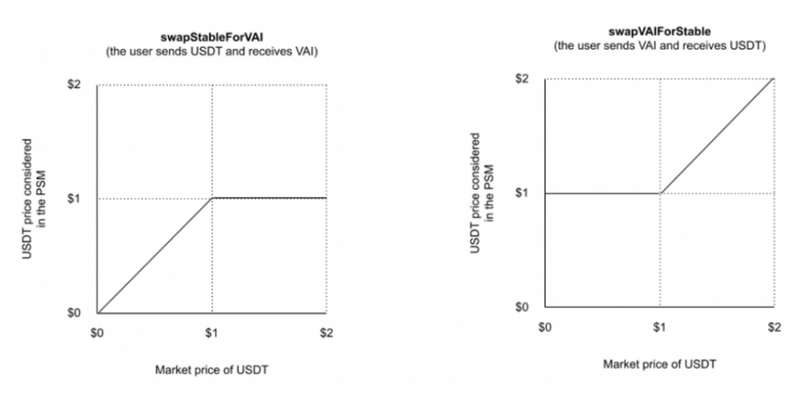
Source: Venus
A significant development occurred in August with the implementation of VIP-157. This proposal raised the base rate of VAI from 1% to 4%, positioning it slightly below other stablecoin borrow rates. It also activated the Peg Stability Module (PSM). Drawing inspiration from the DAI PSM developed by MakerDAO, the VAI PSM seeks to maintain the peg at $1 by fostering a stable and liquid trading environment with bi-directional arbitrage opportunities.
Within the PSM, users can seamlessly swap between VAI and USDT at a fixed rate, with 1 VAI hard-coded to $1. So, whenever VAI’s price dips below $1 in the open market, it becomes a more attractive proposition for users and bots to purchase it at a discount. This buying action pushes the price closer to the $1 benchmark. Once acquired, users can then channel this VAI to the PSM, securing an immediate USDT return. On the flipside, if VAI’s price rises above $1 on any exchange, users can profit by sending USDT to the PSM, receiving VAI at the fixed rate of $1 per VAI. Selling this VAI applies downward pressure on its price, bringing it closer to the $1 peg.
Swapping from USDT to VAI through the PSM is fee-free and allows users to bypass the 4% borrow rate imposed on minters. However, a fee of 10 basis points is applied when swapping from VAI back to USDT. This 10 bps spread is strategically set to ensure VAI maintains a tight peg to USDT, while also allowing third-party liquidity providers on other exchanges to remain competitive with different fee tiers. The next phase to amplify VAI utility and increase demand involves introducing a VAI Savings Rate (VSR), reminiscent of MakerDAO’s DAI Savings Rate. Once these mechanisms can reliably maintain the peg to $1 USD, VAI minting will be reactivated.
The next development involves executing on Venus’ cross-chain roadmap, expanding the protocol’s reach to Ethereum’s Layer-2 solutions and giving VAI multichain wings. Via Snapshot, the community voted to deploy Venus Protocol on both Polygon zkEVM and Arbitrum. Notably, the proposal from Polygon Labs included a $100,000 MATIC grant to incentivize the Polygon zkEVM deployment, with an additional $50,000 to be rewarded upon reaching TVL benchmarks of $10 million and $25 million.
Closing Summary
Venus witnessed a unique shift in user activity in Q3. While there was a 27% decline in borrowers, daily depositor activity increased by 117%. This suggests that much of the activity was related to supporting existing loans. The total value supplied in Venus’ Core pool decreased 18% QoQ, primarily due to significant outflows of major assets like BTC, USDT, BUSD, and ETH. This decline was in part also due to VIP-161, which aimed to address the deprecation of BUSD. However, there were also notable inflows in BNB, USDC, and WBETH, indicating a shift in collateral preferences within the Venus ecosystem. On the revenue front, after three consecutive quarters of growth, the interest revenues earned from Venus markets experienced a slight 4% QoQ decline.
The Venus team invested $300,000 in smart contract audits for the remaining features of the Venus V4 upgrade. The Venus Prime program, set to launch in Q4, aims to boost user engagement and XVS staking by offering enhanced yields through the Automatic Income Allocation module. In August, VIP-157 was implemented to adjust the base rate of VAI and introduced the Peg Stability Module (PSM) to maintain VAI’s peg to $1. The PSM allows users to swap between VAI and USDT at a fixed rate, ensuring price stability. In the coming quarters, the Venus team plans to introduce the VAI Savings Rate and expand Venus’ reach across multiple chains.




















